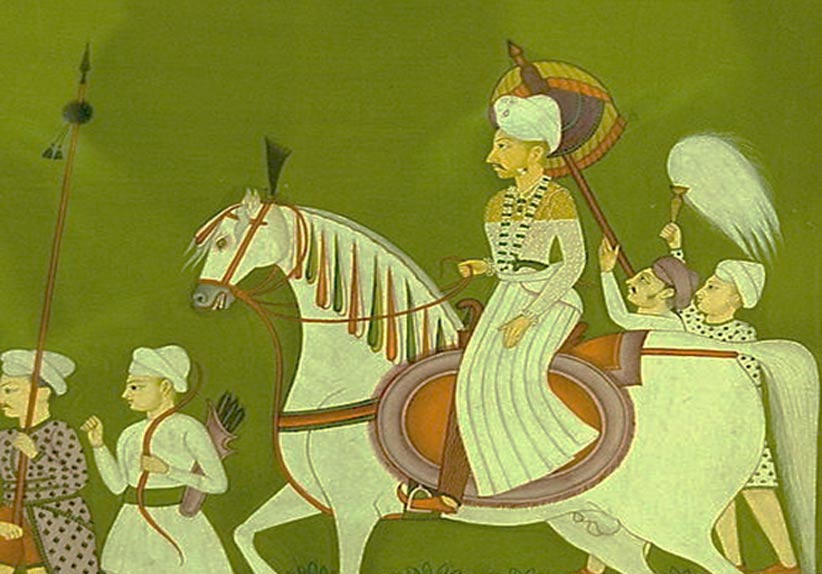Bajirao I – Prime Minister of the Maratha Empire and a Man of the Battlefield
Bajirao I was born on August 18, 1700. From April 27, 1720 until April 28, 1740 he served as Peshwa (Prime Minister) to the Maratha king Chhatrapati Shahu. Bajirao I was also known as Thorale Bajirao and Bajirao Ballal. Apart from his role as prime minister, he was also a general of the Maratha Empire in India. He expanded the Maratha Empire mainly in the north and he was the most influential of the nine Peshwas of the Bhat family. Even though he had a military career of 20 years, he never lost a battle.
A Controversial Personal Life
As for his personal life, it was very controversial. His first wife was Kashibai and together they had three sons: Balaji Baji Rao also known as Nana Saheb, Raghunath Rao, and Janardan Rao who died young. In 1740, after Bajirao’s death, Nana Saheb succeeded him as Peshwa.
Bajirao’s second wife was Mastani and he was deeply in love with her. She was the daughter of Chhatrasal. Bajirao built her a palace located in Pune. The place was called the Mastani Mahal. At the Raja Dinkar Kelkar Museum in Pune a reconstruction of the palace can be seen. One interesting aspect to note about the reconstruction is that it includes remains of the original palace.

An equestrian statue of Peshwa Bajirao I outside the Shaniwar Wada (Shaniwar Palace) in Pune. (CC BY-SA 3.0)
Despite Bajirao’s great love for his second wife, the Hindu Brahmin society of the time refused to accept the marriage. This was due to the fact that Mastani’s mother was a Muslim. All of this resulted in a crisis in the Bhat family. Radhabai, Bajirao’s mother, and his brother, Chimnaji Appa, never accepted Mastani as part of the family. As a result, Chimnaji Appa made many attempts to take her life. However, she survived with the help of Chhatrapati Shahu.
- Manikarnika Ghat and the Role of Cremation in Traditional Indian Funerary Rites
- The Toraja people and the most complex funeral rituals in the world
Bajirao and Mastani had a son in 1734. At birth, he was named Krishna Rao, but when Bajirao wanted him to be accepted as a Brahmin, the priests refused. Because of the Muslim faith of his mother, they did not want to perform the Hindu naming ceremony for him called the upanayana.
As a result, the boy was brought up as a Muslim and was given the name Shamsher Bahadur. At the age of six, Kashibai took the boy and cared for him as one of her own. Later on, he was bestowed part of his father’s dominion in Kalpi and Banda.

A painting said to be of Mastani. (Public Domain)
In 1761, the Third Battle of Panipat took place. The young man aged almost 27 fought with his army alongside the Peshwa, but died in the battle. Shamsher Bahadur’s son named Ali Bahadur reigned over Bajirao’s lands in Bundelkhand. He founded the state of Banda.
Two Deaths
While inspecting his jagirs in 1740, Bajirao died of a sudden fever or a stroke. He had planned to go to Delhi with 100,000 men. They were camped near the city of Indore, in the district of Khargon. On the April 28th that year, Bajirao was cremated on the river Narmada at Raverkhedi.
A chhatri (a dome-shaped pavilion) was built as a memorial on the spot. The memorial was then enclosed by a type of sanctuary called a dharmashala. There are also two temples on the site, one dedicated to Shiva and the other dedicated to Rama.
As for Mastani, soon after hearing about her husband’s death, she died near Pune, at Pabal Village. The cause of her death is not certain. Some believe she died of shock after hearing about the death of her beloved husband, while others claim that she committed suicide as sati (a funeral custom in the past when a wife committed suicide soon after her husband’s death). Mastani’s grave is located in Pabal. It is called Mastani’s mazaar or Samadhi.

Bajirao memorial at Raverkhedi. (CC BY-SA 3.0)
Remembering a General Who Never Lost a Battle
As mentioned before, Bajirao never lost a battle during his life. Out of his many campaigns, one can mention here the campaign against the Nizam, the Malwa campaign, the Bundelkhand campaign, the Gujarat campaign, and the campaign against the Siddis.
Bajirao remains famous for his rapid tactical movements in battle. He used his cavalry and employed total warfare on the enemy. For this reason, he is at times called a cavalry general. For example, Bajirao’s victory at Palkhed was due to great strategic mobility. Bajirao knew how to use the local terrain, he encircled the enemy quickly, used rapid troop movement to cut off the enemy supply lines, distracted the enemy’s attention, chose the battlefield, attacked from unexpected directions, appeared from the rear of the enemy’s army, and generally he kept the enemy off balance.
- The Sushruta Samhita and Plastic Surgery in Ancient India, 6th century B.C.
- Jauhar - The History of Collective Self Immolation during War in India

An information plaque just below the statue of Bajirao Peshwa describes him as RannMard or 'Man of the battlefield'. (CC BY SA 3.0)
In present day India, Bajirao is remembered as a great hero of the battlefield and as a complex warrior. The 2015 movie entitled “Bajirao Mastani” depicts the love story of Bajirao and his second wife, Mastani, as well as Bajirao’s great skills in battle.
Featured image: Peshwa Balaji Baji Rao. Prince of Wales museum, Mumbai. Source: CC BY 2.0
By Valda Roric
References:
Valda Roric – “From History to Mystery”
“The Timechart History of India”
Angelo Morretta – “The Spirit of India”



















